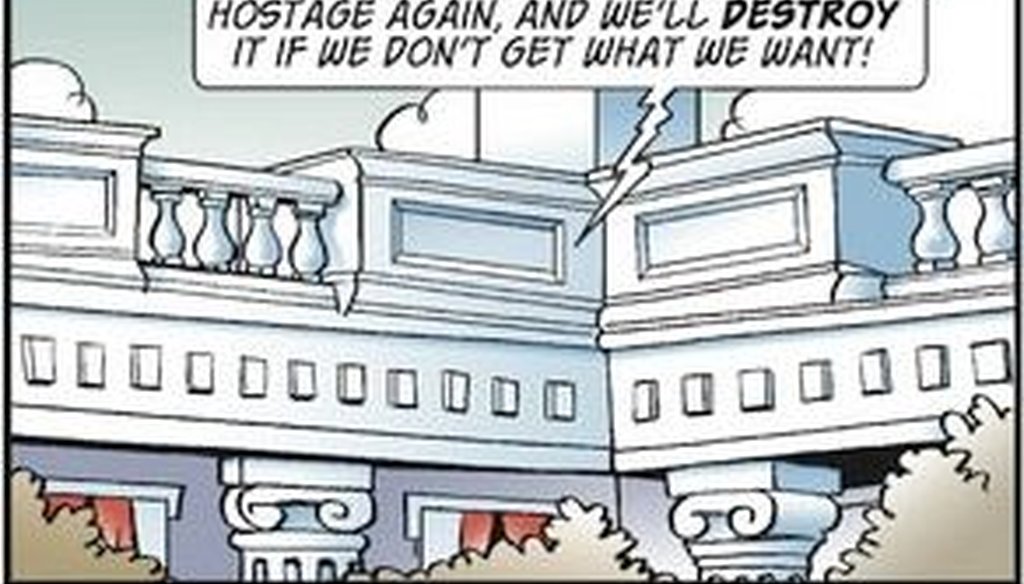

Our only agenda is to publish the truth so you can be an informed participant in democracy.
We need your help.


Lest we forget that the deal that ended the October government shutdown provided only some breathing room and not a lasting fix, the comic strip Doonesbury reminded us that a second crisis is possible.
On Sunday, Doonesbury creator Garry Trudeau offered this conversation between disembodied voices coming from the White House.
"Who’s calling please?"
"Thirty extremists from gerrymandered districts. We’re going to take the economy hostage again and we’ll destroy it if we don’t get what we want."
"But the last time you tried that, the economy bled $24 billion and you got nothing."
The conversation ends when the caller is transferred to the Obamacare hotline where all lines are down and the call goes dead.
Our interest is in the claim of a $24 billion hit on the economy from the standoff over Obamacare and the debt ceiling. Eventually -- once the final economic data is released early next year -- we'll have a good idea of how much of a hit the economy took from the shutdown. But for now, we have to estimate it. So how large are the most reliable estimates? We found that the $24 billion figure, which emerged when the shutdown ended in mid-October, still holds water, although it’s at the high end of the estimates.
Trudeau told PunditFact that he relied on the estimate from Standard and Poor’s. Analysts there wrote on Oct. 16 that GDP for the fourth quarter would be 0.6 percent less than it would have been. That translates into $24 billion. The losses stem from consumers trimming their spending, delays in processing export and import permits, small business loans that got held up and dozens of other tiny but significant ways that private-sector activity crosses paths with the government.
At the peak of the impasse, estimates of the economic impact varied. JP Morgan came in at the low end with a 0.2 percent drop in GDP, or about a $12 billion hit. Economists at Goldman Sachs and the consulting firm IHS thought it would be 0.5 percent.
About five days after the shutdown ended, Moody’s Analytics produced a damage report. They also thought half a percentage point off of growth, or roughly $20 billion, was the right number. Moody’s went a bit further and warned that the impact was not limited to just the days that the government remained shuttered.
"As long as lawmakers stay deadlocked over the direction of the federal budget, the economic recovery will not gain momentum," chief economist Mark Zandi wrote. "Consumers and businesses will remain on edge, holding back spending, investment and hiring."
About a week after the government re-opened, the White House produced one of the lower estimates. The President’s Council of Economic Advisers looked at eight different measures of economic activity and came up with a figure of about 0.25 percent which would mean about a $14 billion loss in growth. The council said such a drop cost the country 120,000 jobs.
The Congressional Research Service, the nonpartisan policy research arm of Congress, summarized what was known as of early November but did not offer its own estimate. That report emphasized it will be several months before all the hard data is in that will allow a detailed accounting. Also in November, Bloomberg News surveyed over 70 economists and found that the consensus was the shutdown had trimmed fourth quarter annualized growth by about 0.4 percent, or $16 billion.
By mid December, top-level budget negotiations between Rep. Paul Ryan, R-Wis., and Sen. Patty Murray, D-Wash., are slated to produce a spending plan that will carry the country beyond the Jan. 15, 2014, deadline set in the deal that ended the shutdown. There have been encouraging signs of compromise but even if a plan emerges, it must still make it through the House -- which is where the trouble started last time.
Our ruling
Doonesbury, aka Garry Trudeau, said the government shutdown cost the economy $24 billion. That is based on the highest of the independent estimates. The others are lower. Three prominent forecasters, Goldman Sachs, IHS and Moody’s assessed the damage at $20 billion. A survey of economists set $16 billion as the most likely figure.
There is broad agreement that the political impasse produced uncertainty that puts an ongoing, if unquantified, damper on growth.
Trudeau likes to say he aims for verisimilitude and he achieved that with his use of a high but defensible estimate from an independent source.
We rate the claim Mostly True.
Doonesbury, Dec. 1, 2013
CNN Money, Shutdown took $24 billion bite out of economy, Nov. 17, 2013
Factcheck.org, Democrats exaggerate shutdown costs, Oct. 22, 2013
New York Times, Gridlock has cost U.S. billions, and the meter is still running, Dec. 16, 2013
Office of Management and Budget, Impacts and costs of the government shutdown, Nov. 7, 2013
Congressional Research Service, The FY2014 government shutdown: Economic effects, Nov. 1, 2013
Pragmatic Capitalism, Goldman Sachs: Shutdown Could Shave Q4 GDP by 0.5%, Oct. 14, 2013
Moody’s Analytics, A budget battle postmortem, Oct. 21, 2013
Bloomberg, Fourth-quarter U.S. GDP forecasts lowered on shutdown, Nov. 1, 2013
President’s Council of Economic Advisers, Economic activity during the government shutdown and debt limit brinksmanship, Oct. 22, 2013
Politico, Paul Ryan, Patty Murray, closer to budget deal, Dec. 2, 2013
Email interview with Katherine Smith, media relations manager, IHS, Dec. 2, 2013
Email interview with Garry Trudeau, creator of Doonesbury, Dec. 2, 2013
In a world of wild talk and fake news, help us stand up for the facts.
